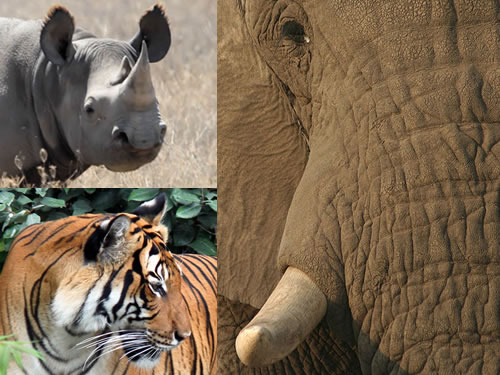
A “wildlife crime scorecard” released by WWF reveals that laws prohibiting commercial trade in rhinos, tigers, and elephants remain poorly enforced throughout Asia and Africa.
23 range, transit, and consumer countries from Asia and Africa were selected for the study, which evaluates the progress made since CoP15 in 2010, regarding illegal trade in ivory, rhino horn and tiger parts. Countries were given “scores” of green, yellow, and red to “indicate whether governments are moving in the right direction to curb illegal trade in these species groups, or to indicate whether they have made little progress”.
A green score indicates “some progress in key aspects of compliance and enforcement”; yellow means “failing on key aspects of compliance or enforcement”, while red is reserved for countries which are “failing on key aspects of compliance and enforcement”.

Yellow = Failing on key aspects of compliance OR enforcement.
Red = Failing on key aspects of compliance AND enforcement.
Rhino horn trade
Vietnam and Mozambique were the only two countries which received red scores regarding illegal rhino horn trade.
Vietnam was identified as the primary destination for South African rhino horn, yet authorities have not made any seizures since 2008. Law enforcement follow-up by Vietnamese authorities is lacking for Vietnamese nationals arrested in South Africa. Vietnamese nationals have also acquired hundreds of rhino horns legally via trophy hunts in South Africa, while Vietnam has been unable to ensure that these horns were for “non-commercial purposes”. In addition, penalties for possessing rhino horn and for trading in rhino horn (both on and off the Internet) are inadequate.
Mozambique has failed to “enforce its border areas” and has not “coordinated” with other countries on the matter of illegal rhino horn trade, despite a high number of Mozambican nationals being arrested in South Africa for rhino crimes.
South Africa received a yellow score for its efforts to combat illegal rhino horn trade. Although it has “made great strides in compliance and enforcement since 2009-2010”, South Africa continues to fail in key enforcement areas and the number of rhinos killed illegally continues to rise.
China “was the only country to receive a green score for rhinos”. It was noted that China’s 1993 ban on the use of rhino horn in traditional Chinese medicine remains in place, and that “an entrepreneurial project to breed white rhinos imported from South Africa for their horns has not been given permission by the government to engage in any rhino horn trade”.
Tiger trade
Vietnam was again one of two countries to receive a red score, this time for tigers, along with Laos.
Vietnam’s government is viewed as “undermining” efforts to thwart illegal trade in tiger parts by permitting the establishment of “pilot breeding farms” for tigers. This action was followed by a 2012 proposal by Vietnam’s CITES Management Authority to allow traditional medicines to be made out of “dead tigers from captive facilities”. A large volume of tiger carcasses continue to be seized in Vietnam, suggesting that captive tigers are already supplying the illegal market. There is apparently no policy in place to address online advertisements for tiger products.
Laos is identified as another country which has failed to prevent captive tiger parts from entering the illegal market. A tiger breeding farm which claims to be in the business of “delivering tiger carcasses to Viet Nam for making tiger bone medicine” was discovered in Thakhek, near the Vietnamese border. An agent of one of these companies is being prosecuted in South Africa for illegal trade in rhino horn, while a significant number of lion bones and lion skeletons have been imported from South Africa, likely for use in tiger bone medicine.
Despite being home to thousands of captive tigers on “tiger farms” and stockpiling frozen tiger carcasses, China received a green score for tigers. The report stated that China had “tightened regulation” of captive animals, but that it remains “unclear if these measures are being enforced to a degree sufficient to prevent illegal trade from these facilities”. The green score was based on “significant progress implementing CITES requirements since 2010”.
Elephant ivory trade
Several countries received red scores for elephants: Cameroon, Central African Republic (CAR), DR Congo (DRC), Egypt, Mozambique, Zambia, Laos, Myanmar, and Thailand.
Regarding Central Africa, the region has endured “the highest rates of elephant poaching in Africa in recent years” and “a general lack of progress on enforcement” is exhibited by all Central African countries named in the report.
Egypt was found to be making little or no effort to comply with the CITES Action Plan to Control Trade in Elephant Ivory. The country is the largest market for illegal ivory “items” on the African continent and although 9,000 ivory items were documented for sale in an April 2011 survey covering two cities, no ivory seizures have been made from retail outlets for nine years.
Mozambique and Zambia’s red scores came as a result of recent ivory thefts from government stockpiles in both countries during the past few months, with the incident in Zambia developing into a “political scandal”. Both countries also have “significant illegal internal ivory markets”.
Red scores for Laos, Myanmar, and Thailand were due to the countries’ universal failures to enforce domestic ivory trade policies. Loophole abuse stemming from trade in ivory sourced from domesticated Asian elephants and elephants “dying of natural causes” is rampant.
Although China was the destination for “a minimum of 54 percent of intercepted large consignments (more than 1,000 kg) of illegal African ivory”, it received a yellow, not a red, score for elephants. China’s internal ivory trade control system “was previously vetted through a CITES process” which requires companies to obtain a Certificate of Registration from the government. It is worth mentioning that four NGO surveys conducted in 2011 found “widespread” abuse of China’s registration system, indicating that China has failed to enforce its own trade regulations.
For example, licensed vendors offered TRAFFIC investigators discounts of 10 – 30 percent if the seller could retain the identification card, in violation of controls which stipulate the card is to remain with the registered item, suggesting the re-use of identity cards to launder illegal ivory.
India and Nepal
Two countries received green scores for all three species: India and Nepal. India was praised for “indications that enhanced enforcement is providing a mitigating effect” on illegal wildlife trade, and Nepal was singled out for the “development of its community-based intelligence networks”.
Nepal went an entire calendar year without losing a single rhino to wildlife traffickers.
‘Corruption and lack of political will’
The illegal trade in wildlife is estimated at 7 to 10 billion dollars per year, according to a May 2012 statement by Tom Cardamone, Managing Director of Global Financial Integrity (GFI).
However — despite the evidence that this scourge is controlled by organized crime syndicates, provides funding to armed insurgents, and indeed poses a threat to global security — addressing the issue of wildlife trafficking is not yet a priority for most governments.
Exemplified by “corruption and lack of political will to combat illegal wildlife trade”, too many countries demonstrate a glaring disconnect between policies on paper and actual enforcement — while significant prosecutions for wildlife crime remain few and far between.
Source: Wildlife Crime Scorecard: Assessing compliance with and enforcement of CITES commitments for tigers, rhinos and elephants via WWF.
Photo used in according with WWF media guidelines and may not be downloaded from this site.




